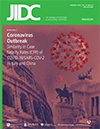Antibiotic resistance profile of commensal Escherichia coli isolated from healthy sheep in Qatar
DOI:
https://doi.org/10.3855/jidc.11827Keywords:
Antibiotic resistance, Qatar, Sheep, E. coliAbstract
Introduction: The uncontrolled antibiotics use in livestock is a leading factor for the emergence and spread of resistant bacteria from food animals to humans through the food chain. This study aims at evaluating the magnitude of the antimicrobial resistance (AMR) in food animals, acknowledging the lack of information on the prevalence of resistance in the veterinary field in Qatar.
Methodology: Rectal samples were collected from 171 sheep across three localities in Qatar between December 2016 and July 2017. These rectal samples were suspended in Phosphate buffer solution (PBS). Then streaked onto a selective CHROMagar E. coli medium plates and incubated at 37°C for 18 to 24 h. Isolated E. coli were tested for antibiotic susceptibility against 16 clinically- relevant antibiotics using the E-test method. Statistical analyses were performed using SPSS statistics 24.
Results: E. coli was isolated from 144 samples (84.2%), of which 90% were resistant to at least one antibiotic and 44% were multi-drug resistant (MDR). The highest resistance was against ciprofloxacin 69.4% (100), followed by nitrofurantoin 47.2% (68), trimethoprim/sulfamethoxazole 45.8% (66), cephalothin 43% (62) and amoxicillin/clavulanic acid 18% (26). Low resistance was reported to fosfomycin, amikacin and tigecycline 1.4% (2), 0.7% (1), and 0.7% (1), respectively.
Conclusions: We reported high MDR E. coli in rectal swabs of sheep in Qatar. Such resistant bacteria can potentially be transmitted to humans, resulting in public health concerns. This requires a quick response to develop and implement a stewardship program for the monitoring of antibiotic use in the veterinary in Qatar.
Downloads
Published
How to Cite
Issue
Section
License
Authors who publish with this journal agree to the following terms:
- Authors retain copyright and grant the journal right of first publication with the work simultaneously licensed under a Creative Commons Attribution License that allows others to share the work with an acknowledgement of the work's authorship and initial publication in this journal.
- Authors are able to enter into separate, additional contractual arrangements for the non-exclusive distribution of the journal's published version of the work (e.g., post it to an institutional repository or publish it in a book), with an acknowledgement of its initial publication in this journal.
- Authors are permitted and encouraged to post their work online (e.g., in institutional repositories or on their website) prior to and during the submission process, as it can lead to productive exchanges, as well as earlier and greater citation of published work (See The Effect of Open Access).








